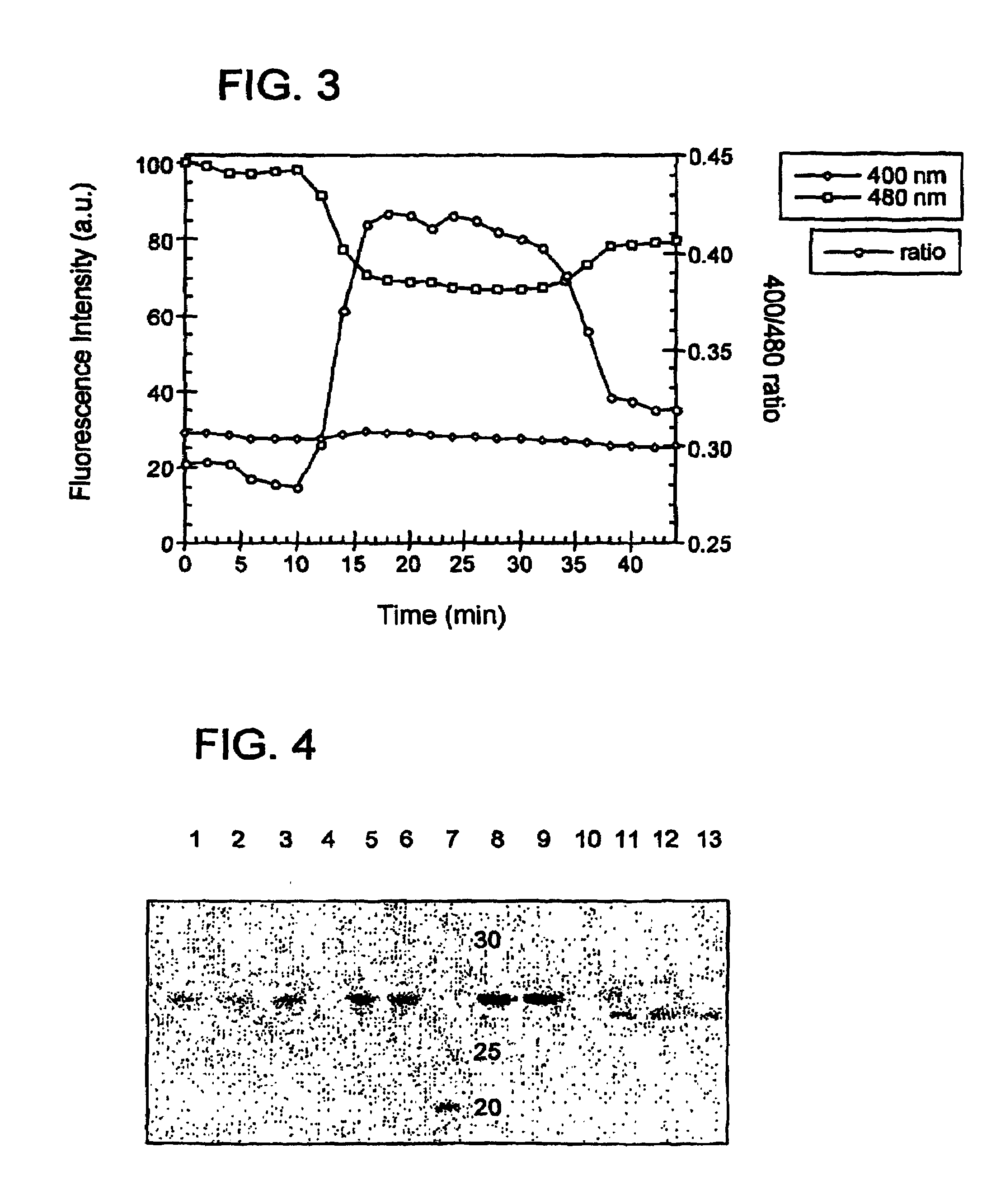Oxidation reduction sensitive green fluorescent protein variants
a green fluorescent protein and variant technology, applied in the field of gene engineering, can solve the problems of inability to monitor redox changes within the same cell with this technique, and the current methods of determining in vivo redox status have many limitations, and can not be used in tissue culture, etc., to achieve the effect of reducing the number of redox changes, and improving the redox ra
- Summary
- Abstract
- Description
- Claims
- Application Information
AI Technical Summary
Benefits of technology
Problems solved by technology
Method used
Image
Examples
example 1
Selection and Design of Redox-Sensitive GFPs
[0171]In order to create redox-sensitive GFPs, two cysteine residues were introduced into GFP that would be within disulfide bonding distance of each other, near the chromophore, and on the surface of the protein. The cysteine residues bring about fluorescence changes based upon whether they are reduced or oxidized. In addition, by being on the surface of the protein, the cysteines are solvent accessible, which enables them to reversibly respond to redox changes in the surrounding environment.
[0172]After close examination of the crystal structure of the S65T variant of GFP, two borderline suitable sites for the introduction of a pair of cysteines were chosen. The first site chosen was positions 147 and 204, while the second site chosen was positions 149 and 202. All four amino acid side-chains at these positions pointed away from the protein's interior. The distance between the Cα—Cα and Cβ—Cβ positions for site one were 4.6 Å each, and fo...
example 2
Construction and Expression of Redox Sensitive GFPs
[0173]Wild-type GFP contains two cysteine residues at positions 48 and 70. To avoid possible thiol / disulfide interchange reactions with the newly engineered cysteines, cysteine 48 and cysteine 70 were replaced with serine and alanine, respectively. Although the substitution C48S did not alter the properties of GFP, C70A appeared to be deleterious to obtaining soluble, fluorescent protein. Since position 70 is located within the interior of GFP and is in close proximity to the chromophore, it was deemed a mutation-sensitive position and was therefore left as a cysteine.
[0174]The C48S mutation was introduced into a histidine-tagged version of the S65T variant of GFP in the plasmid pRSETB. This construct served as the template for introduction of the cysteines at sites one (S147C / Q204C) and two (N149C / S202C). All mutations were introduced via the QUICKCHANGE™ Site-Directed Mutagenesis Kit (Stratagene, La Jolla, Calif.), following the m...
example 3
Disulfide-Bond Formation and Redox Sensitivity of rosGFPs
[0178]Samples of rosGFP2 and GFP S65T (control) were treated with 1 mM DTT or 1 μM CuCl2 and incubated at room temperature for 3–4 hours, then 2 mM N-ethyl maleimide was added to prevent disulfide exchange reactions. Molecular weights were determined by comparison to BENCHMARK™ protein ladder (Invitrogen, Carlsbad, Calif.). The gel was visualized with Coomassie blue stain.
Results
[0179]To verify that the introduced cysteines formed disulfide bonds and to show that the disulfide bonds were intramolecular, SDS-PAGE was run on redox-sensitive GFP #2 (rosGFP2), harboring the mutations C48S / S65T / S147C / Q204C, and on a control GFP (C48S / S65T) under reducing and non-reducing conditions. If an intramolecular disulfide bond forms, the resulting polypeptide would be expected to migrate further based on its slightly more compact structure in the denatured form. However, if an intermolecular disulfide bridge forms, then a large molecular we...
PUM
 Login to View More
Login to View More Abstract
Description
Claims
Application Information
 Login to View More
Login to View More - R&D
- Intellectual Property
- Life Sciences
- Materials
- Tech Scout
- Unparalleled Data Quality
- Higher Quality Content
- 60% Fewer Hallucinations
Browse by: Latest US Patents, China's latest patents, Technical Efficacy Thesaurus, Application Domain, Technology Topic, Popular Technical Reports.
© 2025 PatSnap. All rights reserved.Legal|Privacy policy|Modern Slavery Act Transparency Statement|Sitemap|About US| Contact US: help@patsnap.com



